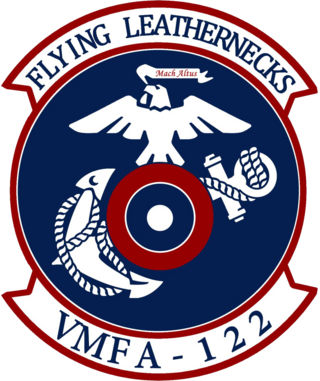
Marine Fighter Attack Squadron 122 (VMFA-122) is a United States Marine Corps fighter attack squadron flying the F-35B Lightning II. The squadron is based out of Marine Corps Air Station Yuma, AZ and falls under the command of Marine Aircraft Group 13 (MAG-13) and the 3rd Marine Aircraft Wing. The squadron nickname is the "Flying Leathernecks," and their traditional radio call sign is "Nikel". On 14 November 2017, VMFA-122 opened a new chapter of their history, transitioning from the McDonnell Douglas F/A-18C Hornet to the Lockheed Martin F-35B Lightning II and moving from MCAS Beaufort and MAG-31, 2nd MAW to MCAS Yuma and MAG-13, 3rd MAW.

Marine Fighter Attack Squadron 311 (VMFA-311) is a United States Marine Corps fighter attack squadron consisting of F-35C Lightning II. Known as the "Tomcats", the squadron is based at Marine Corps Air Station Miramar, California and falls under the command of Marine Aircraft Group 11 (MAG-11) and the 3rd Marine Aircraft Wing.

Marine All Weather Fighter Attack Squadron 224 is a United States Marine Corps (USMC) F/A-18 Hornet squadron. Also known as the "Fighting Bengals", the squadron is based at Marine Corps Air Station Beaufort, South Carolina and falls under the command of Marine Aircraft Group 31 (MAG-31) and the 2nd Marine Aircraft Wing. The Bengals are the only Marine F/A-18D Hornet Squadron currently operating out of MCAS Beaufort.
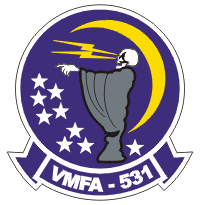
Marine Fighter Attack Squadron 531 (VMFA-531) was a United States Marine Corps fighter squadron consisting of various types aircraft from its inception culminating with the F/A-18 Hornet. Known as the "Grey Ghosts", the squadron participated in action during World War II and the Vietnam War. They were decommissioned on 27 March 1992.

Marine Fighting Squadron 313 (VMF-313) was a reserve fighter squadron in the United States Marine Corps. They were a part of the 4th Marine Aircraft Wing and stationed at Naval Air Station New York. Also known as the "Lily Packin' Hellbirds" and the "Lilly Packin' Death Falcons", they fought in World War II mainly during the Philippines Campaign, 1944-45. The squadron was decommissioned in the 1950s.

Marine Fighter Attack Squadron 334 (VMFA-334) was a United States Marine Corps fighter squadron. Known as the "Falcons", it was part of Marine Aircraft Group 15 and Marine Aircraft Group 33. The squadron participated in action during World War II and the Vietnam War and was decommissioned in 1971.
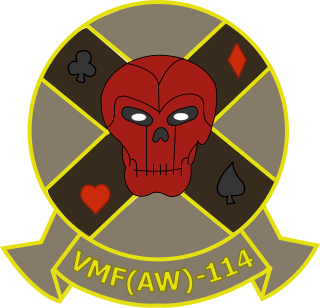
Marine All-Weather Fighter Squadron 114 was a squadron of the United States Marine Corps that was originally commissioned during World War II. Nicknamed the "Death Dealers", the squadron saw the most action during the war providing close air support during the Battle of Peleliu. The squadron remained on active duty until being decommissioned in 1963.

Marine Transport Squadron 216 (VMR-216) was a reserve cargo squadron of the United States Marine Corps that was based out of Washington. Known as the "Bulldogs", VMR-216 started out as a fighter squadron and participated in numerous combat engagements in the Pacific Theater during World War II to include the Battle of Guam and the Battle of Iwo Jima. The squadron was decommissioned shortly after the end of the war but was reactivated in 1946 as part of the Marine Air Reserve. The squadron remained in the Reserve until being decommissioned on 21 December 1972.

Marine Fighting Squadron 215 (VMF-215) was a fighter squadron of the United States Marine Corps that was commissioned and fought during World War II. Known as "The Fighting Corsairs", the squadron fought in many areas of the Pacific War, including the Battle of Bougainville. During its four-and-a-half month tour, the squadron was credited with shooting down 137 enemy aircraft, fourth most in Marine Corps aviation history.

Marine Fighting Squadron 222 (VMF-222) was a fighter squadron of the United States Marine Corps that was activated and fought during World War II. Known as "The Flying Deuces," they fell under the command of Marine Aircraft Group 14 (MAG-14) and fought in many areas of the Pacific War, including the Philippines campaign (1944–45) and the Battle of Okinawa. During the war, the squadron was credited with shooting down 53 enemy aircraft and was the sister squadron to VMF-215. They were deactivated on 31 December 1949.

Marine Fighting Squadron 511 (VMF-511) was a fighter squadron of the Marine Corps and Marine Forces Reserve during World War II and the Cold War which flew aircraft types such as the F6F Hellcat, F4U Corsair, and the F-8 Crusader. They were originally activated during World War II and fought during the Battle of Okinawa and the Battle of Balikpapan (1945). They specialized in close air support and during the course of the war were credited with only one plane shot down.

Marine Fighting Squadron 218 (VMF-218) was a reserve fighter squadron of the United States Marine Corps that was originally activated during World War II. Known as the "Hellions", they flew throughout the South Pacific but saw the majority of their fighting during the Philippines Campaign (1944–45). The squadron was credited with downing 18 enemy aircraft during the course of the war.
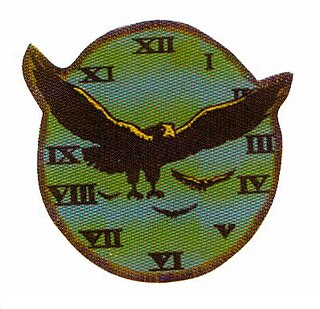
Marine Attack Squadron 543 (VMA-543) was an aviation unit of the United States Marine Corps. The squadron, also known as the "Night Hawks", were part of the Marine Forces Reserve and were based at Naval Air Station Glenview, Illinois until their deactivation on 1 April 1974. Originally activated during World War II, they fought in the Battle of Okinawa as part of the Tactical Air Force. The squadron was credited with downing 15 Japanese aircraft during the war. Following the surrender of Japan, the squadron was deactivated only to be later reactivated as part of the Reserves. They were again deactivated in 1974 and remain in an inactive status today.

Marine Fighter Attack Squadron 124 (VMFA-124) was a flying squadron in the Marine Forces Reserve based out of Naval Air Station Memphis flying the Douglas A-4 Skyhawk. They were part of Marine Aircraft Group 42 and were decommissioned on 19 June 1999.
Air Warning Squadron 2 (AWS-2) was a United States Marine Corps aviation command and control squadron during World War II. The squadron was tasked to provide aerial surveillance and early warning during amphibious assaults. They took part in the Battle of Guam in 1944 and would eventually move to Peleliu in 1945 assuming responsibility for air defense in that sector until the end of the war. The squadron departed Peleliu for the United States in January 1946 and was quickly decommissioned upon its arrival in California. To date, no other Marine Corps squadron has carried the lineage and honors of AWS-2 to include Marine Air Control Squadron 2 (MACS-2).

Marine Fighting Squadron 213 (VMF-213) was a reserve fighter squadron in the United States Marine Corps. Nicknamed the "Hell Hawks", the squadron fought during World War II in the Philippines and at the battles of Iwo Jima and Okinawa. With its assignment to the USS Essex (CV-9) and Air Group 4, VMF-213 along with VMF-124 was one of the first two Marine squadrons to augment carrier air groups during World War II. The squadron was credited with downing 117 enemy aircraft during the war.

The VMF(N)-531 GCI Detachment was a short-lived aviation command and control unit that was part of the United States Marine Corps's first night fighter squadron, VMF(N)-531. This detachment was the Marine Corps' first dedicated GCI detachment utilized in a combat zone. In the early phases of World War II the Marine Corps did not have stand-alone early warning and ground-controlled intercept (GCI) units so these capabilities were initially placed in the headquarters of each Marine Aircraft Group and with individual night fighter squadrons. The detachment was deployed in the South Pacific from August 1943 through August 1944 and was responsible for the interception of numerous Japanese aircraft. Lessons learned from this deployment were instrumental in establishing tactics and procedures for the Marine Corps' newly established Air Warning Program. Upon returning from its first and only deployment, the detachment was dissolved and its members went on to serve as instructors at the 1st Marine Air Warning Group, which was responsible for training new squadrons. Many of them later served in leadership roles in these Air Warning Squadrons as they supported follow on combat operations.

Marine Night Fighter Squadron 532 was a United States Marine Corps night fighter squadron that was commissioned during World War II. The squadron, which flew the F4U-2 Corsair, was the second night fighter squadron commissioned by the Marine Corps, the first to fly a single-seat, radar-equipped night fighter, and the only Marine squadron to fly the F4U-2 in combat. VMF(N)-532 saw extensive combat operations throughout 1944 in support of Marine Corps operations at Kwajalein Atoll and the Mariana Islands. The squadron was decommissioned on 31 May 1947, as part of the post-war draw down of the service. Since then, no other Marine Corps squadron has carried the lineage and honors of VMF(N)-532.
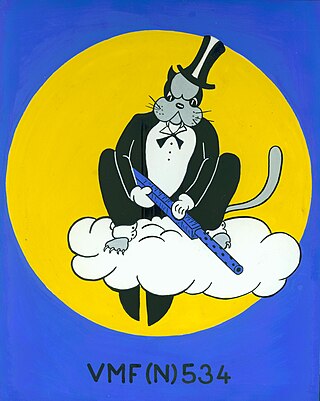
Marine Night Fighter Squadron 534 was a United States Marine Corps night fighter squadron that was commissioned during World War II. It was the fourth night fighter squadron commissioned in the service and participated in limited combat operations throughout 1944 and 1945 during Marine Corps operations over Kwajalein Atoll and the Mariana Islands. The squadron was decommissioned on 31 May 1947, as part of the post-war draw down of the service. Since then, no other Marine Corps squadron has carried the lineage and honors of VMF(N)-534.
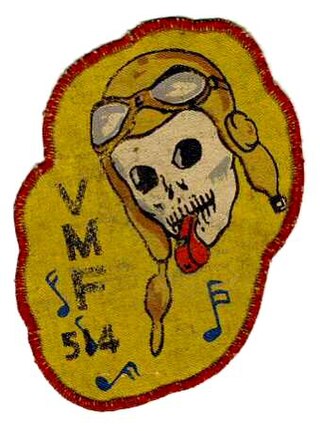
Marine Fighting Squadron 514 (VMF-514) was a short-lived fighter squadron of the United States Marine Corps during World War II. Flying the Vought F4U Corsair, the squadron was originally commissioned to be part of the ill-fated Project Danny, a plan for carrier based Marine Corps aircraft to interdict German V-1 flying bomb launch sites. The squadron did not participate in combat action during the war and was decommissioned on 9 December 1945. No other Marine Corps squadron has carried VMF-514's lineage and honors since that time.




















